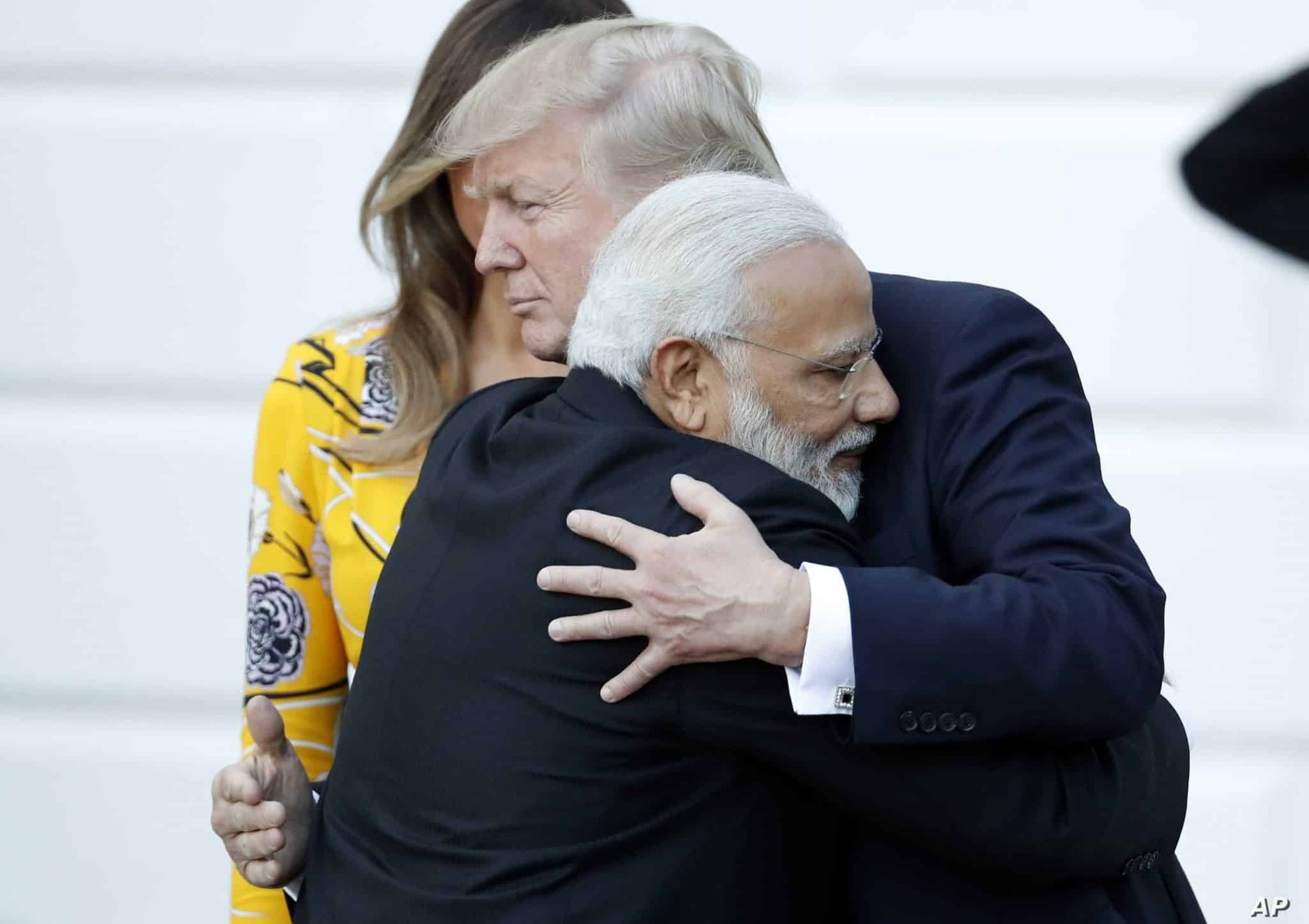With an Eye on China, India Cuts Iran Loose & Embraces the US
by Salman Rafi Sheikh…with New Eastern Oulook, Moscow,…and the Institute of Oriental Studies of the Russian Academy of Sciences, a research institution for the study of the countries and cultures of Asia and North Africa.
[ Editor’s Note: Rather than stay in what was once thought to be the safe middle zone of southeast Asia by balancing relations between Iran and China, India has chosen to side with the US in the brewing new Cold War. Mr. Sheikh has an excellent review below.
India, with its fast developing economy, had been focused on maximizing all trade opportunities in a way similar to what China had been doing, investing in major infrastructure projects that build long term, and hopefully unbreakable ties. That has now been turned upside down.
Why? It appears that India did not feel secure in the fast evolving Cold War development of hugely expensive weapons systems. These contracts are the Olympic gold medals of every major defense contractors, not only for the weapons sale profits, but the maintenance and upgrade contracts that follow that assure decades of cash flow.
This is why the weapons lobby hates peace so much. The profits in the peace economy are peanuts compared to the Cold War economy.
The next big war will see the deployment of the most expensive weapons platforms ever used, with the new hypersonic ones leading the pack. These are so dangerous to all the rest of us that there should have been some kind of push to control them, like nuclear and biological weapons (despite their poor record) due to the devastation they can cost. No progress has been made during the crazy ‘unipolar’ NeoCon administration that Trump brought to Washington.
And second, the yin and the yang in this conundrum is that whoever has the electronic warfare edge can eliminate an attacking country’s vastly expensive weapons platforms, for example making F-35s just fall out of the sky, and maybe even using stealth drones to do this with no human casualties.
India has chosen to go under the US-Israeli umbrella. Tel Aviv ‘nuked up’ India years ago by transferring ballistic missile technology, with hardly a word published about it in our Western fake ‘free press’. You can assume it has mini-nuke technology. The horse is now out of the barn.
Missing from Rafi’s review, and I understand that not everything can be covered in one article, is what will happen to India’s purchase of Iranian petro chemicals, which has been an important export earner for Tehran. And how will this affect China’s New Silk Road plans?
Rafi also mentions below that India did not have much of a domestic weapons production capacity, which surprised me as India has been doing joint weapons production deals with Russia for years, in particular tanks and aircraft, as part of a long term partnership.
As for India’s border issues with Pakistan and China, these have been kept from boiling over, more so with China, showing all sides have been careful not to overplay their hand. We pray that such wisdom continues to prevail… Jim W. Dean ]
 Jim's Editor’s Notes are solely crowdfunded via PayPal
Jim's Editor’s Notes are solely crowdfunded via PayPal
Jim's work includes research, field trips, Heritage TV Legacy archiving & more. Thanks for helping. Click to donate >>

First published … November 08, 2020
India, tied as it is to the US apron strings, has suffered a major strategic set-back in Iran, where not only has it potentially lost exclusive development rights and control of the strategically important port of Chabahar, but has also been kicked out of Farzad-B gas field project.
This has potentially meant a physical death of the ambitious 2013 ‘Tehran Declaration’, which had supposedly tied India and Iran in a strong strategic relationship. While India’s deliberate move away from Iran has taken place against the backdrop of US sanctions on Iran, imposed in the wake of Trump’s decision to force-scrap the JCPOA, these moves are fundamentally rooted in a strategic consensus with the US over Iran.
It is for this reason that India has not pumped enough money even into the Chabahar port, which otherwise is exempted from US sanctions. For India, getting close to the US was/is more important in the wake of its on-going military tensions with China than pursuing relatively low-level strategic interests in Iran.
The path that the Indian policy makers chose to confront China at a broader level required sacrificing their interests in Iran. As it stands, Indian companies previously involved in Farzad-B are now engaged in a similar gas exploration project in Israel, indicating how India has largely moved to the anti-Iran camp.
India’s move away from Iran has allowed it to deepen its strategic relations with the US. Indeed, the immediate result has been the signing of “Basic Exchange and Cooperation Agreement” (BECA), the third so-called “foundational pact” after the “Logistics Exchange Memorandum Of Agreement” (LEMOA) and “Communication Compatibility and Security Agreement” (COMCASA) which collectively improve these countries’ military interoperability.
As an Indian news report explained, the BECA will help India get real-time access to American geospatial intelligence that will enhance the accuracy of automated systems and weapons like missiles and armed drones. Through the sharing of information on maps and satellite images, it will help India access topographical and aeronautical data, and advanced products that will aid in navigation and targeting.
While one may think that the India’s close ties with the US have roots in Trump’s own aggressive China policy, the US policy towards India and India’s relevance for the US against China are unlikely to change even if Trump loses and Biden wins.
Let’s not forget that Biden, when he was Obama’s vice president, was one of the main architects of the so-called “Asia Pivot” policy. India was as relevant to the “Asia Pivot” as it is to Trump’s “Indo-Pacific” strategy. “Indo-pacific” strategy is very much a continuation of “Asia Pivot” in as much as it aims at confronting and containing China and Russia in Asia and beyond.
According to Indian defense experts, the agreement signed will directly help India fight China in Ladakh, and Pakistan in Kashmir. Indian experts have been reported to have said that if the deal had signed earlier, the situation at the Northern border of India could have been different.
Indeed, Mark Esper said that defense agreements between the US and India call for military cooperation and is a check on ‘Chinese aggression’, adding that “Based on our shared values and common interests, we stand shoulder-to-shoulder in support of a free and open Indo-Pacific for all, particularly in light of increased aggression and destabilizing activities by China.”
“Our leaders and our citizens see with increasing clarity that the [Chinese Communist Party] is no friend to democracy, the rule of law, transparency, nor to freedom of navigation, the foundation of a free and open and prosperous Indo-Pacific,” said Pompeo.
Pompeo further categorically said that America would “stand by India” in the fight against China, and paid tribute to the soldiers killed in Ladakh.
With China, rather than Modi-Trump bromance, being the central pillar of US-India strategic relations, it is, therefore, unlikely that the prevalent spirit of deep direct defense ties will die out even if Trump is voted out of the White House.
As India’s former army chief General Nirmal Chander Vij explained, “Over this period we have realized that Indian interests and American interests are [going] in the same direction and for the same purpose – and for that very reason, India has gone ahead and signed the foundational military agreements.”
What is more important for India in the wake of its on-going military tensions with the US is the realization about its lack of military preparedness vis-à-vis China. With no significant arms industry at home, the Indian policy makers see in the US a natural anti-Chin ally, one they would not find in Russia or anywhere else, and a key source of advance military hardware.
To maintain and even deepen this alliance and to further the scope of the so-called 2+2 dialogue, Indian policy makers were not reluctant to tell Iran that their country wouldn’t be able to maintain the spirit of ‘Tehran Declaration.’
It is for this reason that two consecutive visits of India’s foreign and defense ministers to Iran were quickly followed by Iran’s decision to kick India out of Farzad-B gas project, realizing that India’s strategic realities are clearly at odds with its previously widely propagated and ambitious ‘look East’ policy, an idea that imagined a greater Indian reach to Central Asia and Afghanistan via Iran.
Salman Rafi Sheikh, research-analyst of International Relations and Pakistan’s foreign and domestic affairs, exclusively for the online magazine “New Eastern Outlook”.

Jim W. Dean is VT Editor Emeritus. He was an active editor on VT from 2010-2022. He was involved in operations, development, and writing, plus an active schedule of TV and radio interviews. He now writes and posts periodically for VT.
ATTENTION READERS
We See The World From All Sides and Want YOU To Be Fully InformedIn fact, intentional disinformation is a disgraceful scourge in media today. So to assuage any possible errant incorrect information posted herein, we strongly encourage you to seek corroboration from other non-VT sources before forming an educated opinion.
About VT - Policies & Disclosures - Comment Policy





Jim India doesn’t have the infrastructure to accommodate the fleeing production. The transition will take years.
Also the bottom feeders in India have always done this to Iran. Oil minister Zangeneh has seen every song and dance from India when they were squeezing Iran under the pretext of helping under sanctions. And then there is the Israeli pressure which comes with Trump’s help. The truth is that Iran finally dumped India and now that their mango naan and curry is on his way out they have to rethink their investment in the US administration.
I think I saw that the Indidan government was coordinating shifting production. Of course that may not work depending on the products and work done. Mike Harris once moved a semi-production plant in 30 days, to having production starting again.
India the “Kingdom of rags”, even China understands how hard it will be to squeeze money out of them. I guess American tourism to India will enable tourist boats all over Ganges river, of course they need to clean it first.
India and China seem to have their border issue calmed down a bit, but historically that has always been a yoyo where they slip back into the never ending skirmishing mode. The economic war is heating up with US sanctions fears having companies moving out of China to India to get out of the line of fire.
Comments are closed.